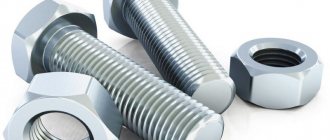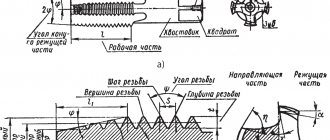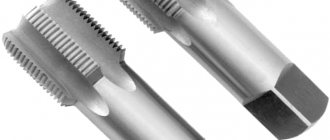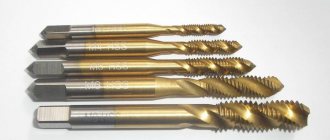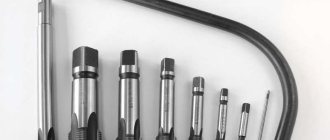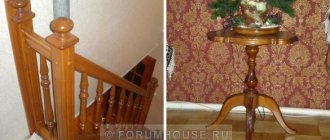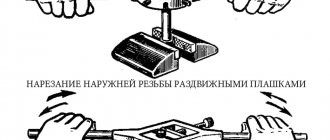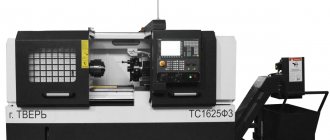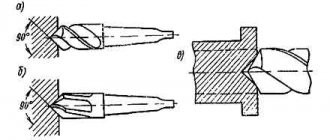Main settings
One of the main tasks of technological preparation of production during turning operations is the determination of rational cutting conditions. When calculating them, the characteristics of the product being processed and the capabilities of the machine park, as well as the availability of appropriate tools, fixtures and equipment should be taken into account. The layout of the components and assemblies of a lathe allows for the implementation of two defining types of movement that form a given configuration of the surfaces of the part: rotation of the workpiece (main movement) and movement of the cutter deep into and along the surface of the part (feed). Therefore, the main technological parameters for turning equipment are:
- cutting depth;
- spindle feed and speed;
- cutting speed.
There is mutual influence of cutting modes and the main elements of the production economy. Among them, the most significant are:
- equipment performance;
- quality production indicators;
- cost of manufactured products;
- depreciation of equipment;
- tool durability;
- safety.
The concept of cutting modes
Turning at extreme conditions increases the productivity of turning equipment. However, such operation of machines is not always possible and advisable, because There are limitations in the form of the maximum power of the main drive, the rigidity and strength of the workpieces, as well as the technological parameters of the tool and equipment.
If the technological parameters are incorrectly calculated or selected, working at high speeds can cause increased vibration and imbalance of individual mechanisms of the lathe. This leads to a decrease in the accuracy and repeatability of product dimensions. In addition, the risk of tool breakage and machine failure increases.
Depth
Allowance is the thickness of metal removed by a turning tool from the workpiece before it reaches the final size. When turning and boring, it is removed in stages over a given number of cuts. The thickness of the metal removed per single cutter pass is called the depth of cut in machining and is measured in millimeters. In technological calculations and tables, this parameter is denoted by the letter t.
During turning operations, it is equal to 1/2 the difference in diameters before and after turning the part and is calculated by the formula:
t = (Dd)/2,
where t is the cutting depth; D—diameter of the workpiece; d – specified diameter of the part.
During trimming operations, this is the size of the metal layer removed from the end of the workpiece in a single pass of the cutter, and during grooving and cutting, this is the depth of the groove.
Depth of cut
Ideally, one pass of the cutter is required to remove the stock. But in reality, the turning process, as a rule, includes a roughing and finishing stage of processing (and for surfaces with high precision - even semi-finishing). If the characteristics and shape of the workpiece are good, both of these operations are performed in two or three passes.
Innings
Feed during turning is the length of the path during the transverse movement of the cutting edge of the cutter, which it makes per unit revolution of the spindle. It is measured in mm/rev, designated in technological documentation by the letter S and selected from technological reference books. The feed amount depends on the power of the main drive, the value of t, dimensions and physical properties of the workpiece being processed. When turning, it is calculated by the formula:
S=(0.05…0.25) ×t,
During the turning operation, the feed on the lathe should be set to the maximum possible number, but taking into account the technological parameters of the machine and the tool used. During rough turning operations, it depends on the power of the main drive and the stability of the part. And in finishing turning, the main criterion is the specified class of surface roughness.
Speed
The cutting speed during turning is the total trajectory of the cutting edge of the cutter per unit time. Its dimension is in m/min, and in tables and calculations it is designated by the letter v and is selected according to technological documentation or calculated using formulas. In the latter case, the calculation occurs in the following sequence:
- the t value is calculated;
- the value S is selected from the reference book;
- the table value vt is determined;
- the adjusted value vут is calculated (by multiplying by correction factors);
- taking into account the spindle rotation speed, the actual value vf is selected.
Cutting speed
This parameter is one of the main performance characteristics of metal-cutting equipment and directly affects the operating conditions of the lathe, tool wear and the quality of the machined surface.
Different taps for different materials
When designing taps for different materials, the rake angle and curvature of the rake surfaces of the tap are usually changed. For difficult-to-cut materials, these parameters have negative or zero values to ensure cutting edge strength. In addition, due to the large curvature of the front surfaces of the tap, when processing such materials, scoring may appear on the threads. When processing materials that produce continuous chips, taps with positive rake angles and a sufficiently large curvature of the rake surfaces are used, due to which the chips curl and break.
Another significant parameter of tap geometry is the clearance angle. For harder materials, high clearance taps are used to reduce friction and allow coolant to reach the cutting zone. But too much clearance reduces the ability of the tap to self-center. When machining ductile materials, too large a relief angle can lead to thread parameters outside the tolerance range.
Taps for cutting threads in blind holes differ from each other in the helix angle. For materials with higher strength, taps with a smaller helix angle are used. This ensures higher strength of the tap itself. For difficult-to-cut materials, taps with a short cutting length are also used to reduce cutting forces.
If you want to improve your threading efficiency, you need to pay attention to more than just the tool. For example, when cutting threads in gray cast iron with taps of the old design, you can process at a cutting speed of 10-15 m/min, and with taps of the new design - 75 m/min. But it must be remembered that such a cutting speed is achievable only under certain conditions. For example, in the absence of an internal coolant supply, the cutting speed will need to be reduced to 45 m/min, since when high-speed steel overheats, its durability is greatly reduced. When processing small threads, the spindle rotation speed may not be enough, and when processing large threads, the power of the equipment, and so on.
In addition to the geometry of the tap, the coating applied to the surface of the tool material is of great importance. Many coatings are used: TiN, TiCN, CrN, TiAlN. Thanks to the use of coatings, tool life increases and reserves appear to increase productivity.
Formulas and definitions for thread turning
Plunge depth
Formulas and parameters for calculating cutting conditions
Thanks to processing the full plunge depth in several passes, the radius at the tip of the cutting insert is not overloaded.
Example: if the plunge depth (radial plunge) per pass is 0.23–0.10 mm, then the total depth (ap) and profile depth (0.94 mm) for a metric thread with a pitch of 1.5 mm will be processed in 6 passes (nap).
| | 1st pass, plunging depth 0.23 mm |
| | |
| | = 0,009″ |
| | |
| | |
| | 2nd pass, plunging depth 0.42 – 0.23 = 0.19 mm |
| | |
| | 0,017 – 0,009 = 0,008″ |
| | |
| | |
| | 3rd pass, plunging depth 0.59 – 0.42 = 0.17 mm |
| | |
| | 0,023 – 0,017 = 0,006″ |
| | |
| | 4th pass, plunge depth 0.73 – 0.59 = 0.14 mm |
| | |
| | 0,029 – 0,023 = 0,006″ |
| | |
| | 5th pass, plunge depth 0.84 – 0.73 = 0.11 mm |
| | |
| | 0,033 – 0,029 = 0,004″ |
| | |
| | 6th pass, plunge depth 0.94 – 0.84 = 0.10 mm |
| | |
| | 0,037 – 0,033 = 0,004″ |
The plunge depth can be calculated using the formula:
Δap = radial infeed, depth of cut per pass
X = pass number (consecutively from 1 to nap)
ap = total thread depth + machining allowance
nap = number of passes
Y = 1st pass = 0.3
2nd pass = 1
3rd pass onwards = x-1
Step 1.5 mmap = 0.94 mmnap = 6
γ1 = 0.3 γ2 =1 γn = x-1
| Parameter | Meaning | Metric units | Inch units |
| ap | Plunge depth, total cutting depth | mm | inches |
| n | Spindle speed | rpm | rpm |
| Vc | Cutting speed | m/min | |
| nap | Number of passes | | |
- DepressionThe surface at the base connecting two adjacent sides of the profile
- Profile flankThe surface of the thread connecting the top and bottom of the profile
- ApexThe surface connecting the two sides of the profile at the outer diameter
P = thread pitch in mm or threads per inch
The distance between two corresponding points of adjacent threads, measured parallel to the axis of the thread.
β = thread profile angle
The angle between the sides of a profile, measured in the axial plane.
φ = helix angle
The angle formed by the tangent to the helical line of the thread at points lying on the mean diameter and the plane perpendicular to the axis of the thread.
Diameter parameters
d = external diameter of male thread
D = outer diameter of internal thread
d1 = internal diameter of external thread
D1 = internal diameter of female thread
d2 = average diameter of external thread
D2 = average internal thread diameter
The effective diameter of a screw thread is approximately midway between the outer and inner diameters.
Thread angle
The lead angle of the thread (φ) depends on the diameter and pitch of the thread. This parameter can be represented as the development of a right triangle. The helix angle of the thread is calculated using the formula below.
Universal thread turning tools
Calculation of electric current by power: formulas, online calculation, selection of machine
As the name implies, this type of cutter is used for cutting threads on parts. Threads can be external and internal, and turning tools are divided into two types, for external processing and for internal processing.
A turning tool for external threads is shown in the picture below.
Turning cutter for processing external threads.
And then a turning cutter for processing the internal thread.
Turning cutter for processing internal threads.
It is worth noting that turning cutters for processing internal diameters can cut threads in holes of sufficiently large diameter. This is explained by the geometric parameters of the cutter holder.
It’s also worth noting with regard to threaded turning tools, as with all universal ones in general, that they cannot be used immediately after bringing them from the store, they need to be sharpened correctly.
Depending on the thread profile, thread cutters are usually sharpened to 60 degrees for metric threads and 55 degrees for inch threads. Sharpening of threaded cutters is carried out using a special template.
Template for sharpening thread cutters.
Next we move on to modern types of turning thread cutters with a replaceable insert.
Power addictions.
Tangential component of the cutting force Pz, N, when cutting threads with cutters
(30)
torque, Nm, when cutting threads with taps, threading heads
(31)
where P is the thread pitch, mm;
— the number of working strokes, established from the table. 24;
D—nominal thread diameter, mm.
Coefficients SR, SM
and exponents are given in table. 27. The correction factor, taking into account the quality of the material being processed, is determined for cutters according to table. 13, for other instruments - according to table. 26.
Modern thread turning tools
GOST 16532-70. cylindrical involute gear transmissions of external gearing. geometry calculation
They are mainly used on CNC machines and have a design consisting of a holder and a replaceable insert, this insert is selected depending on the thread profile.
Thread turning tools for CNC machines
Lathe thread cutters for CNC machines are also divided into external and internal. Their purpose is exactly the same as that of universal thread turning tools.
Modern thread turning tool for external machining in the picture below
Thread turning tool for external machining
And a cutter with a replaceable insert for processing internal threads.
Thread Cutter for CNC Machines for Internal Thread Processing
The cutters presented above have the designations: 266RFG-2525-16 and 266RKF-20-16
Next, we will open the cutter data models in SolidWorks and watch a video animation of processing with these cutters.
Preparing to cut internal threads
In order for the process of cutting internal threads using a tap to not cause any particular difficulties and result in a high-quality result, it is necessary to properly prepare for this technological operation. All methods of cutting threads using a tap assume that a hole with the appropriate diameter has already been made in the workpiece. If the internal thread that needs to be cut has a standard size, then a special table with data in accordance with GOST can be used to determine the diameter of the preparation hole.
Table 1. Diameters of holes drilled for standard metric threads
If the thread that needs to be cut does not belong to the standard category, you can calculate the diameter of the hole to make it using a universal formula. First of all, it is necessary to study the marking of the tap, which must indicate the type of thread being cut, its diameter and pitch, measured in millimeters (for metric). Then, to determine the cross-sectional size of the hole that needs to be drilled for the thread, it is enough to subtract the pitch from its diameter. For example, if a tool marked M6x0.75 is used to cut a non-standard internal thread, then the diameter of the preparation hole is calculated as follows: 6 – 0.75 = 5.25 mm.
For standard threads belonging to the inch category, there is also a table that allows you to choose the right drill with which to carry out the preparatory work.
Table 2. Diameters of holes drilled for inch threads
An important question to obtain a high-quality result is not only the question of what is used to cut the thread, but also what drill to use to make the preparation hole. When choosing a drill, you need to pay attention to the parameters and quality of its sharpening, as well as to ensure that it rotates in the chuck of the equipment used without runout.
The sharpening angle of the cutting part is selected depending on the hardness of the material that needs to be drilled. The higher the hardness of the material, the greater the sharpening angle of the drill should be, but this value should not exceed 140°.
When drilling blind holes, control the drilling depth
How to cut threads correctly? First you need to select tools and consumables:
- an electric drill or drilling machine capable of operating at low speeds;
- a drill whose diameter is calculated or selected using reference tables;
- a drill or countersink, with the help of which a chamfer will be removed from the edge of the prepared hole;
- a set of taps of the appropriate size;
- manual holder for taps (drives);
- bench vice (if the product in which the thread needs to be cut needs to be fixed);
- core;
- hammer;
- machine oil or other composition, which during the processing process must be used to lubricate both the tap and the thread section being cut by it;
- rags.
Diagram of thread cutting with a tap
Quality control
To ensure that the workpiece has been processed correctly, it is necessary to use thread templates. With their help, the thread pitch is checked.
But for a comprehensive assessment, a thread gauge is used. For convenience, it is installed in a rack and adjusted according to a standard or template, then the movement of the part itself is checked.
You can also use the simplest and most commonly used method. Take a nut or bolt and scroll it over the completed part.
If scuffing is noticeable on the thread as you move, or more effort needs to be applied, then you have made an error in your work. Now you already know how to use a lathe to make various nuts, bolts or threaded connections.
It is important to remember that such parts require great care and tenderness with each pass, and even quality control. It’s better to spend more time on work than to ruin several pieces later
Technology for using taps and dies
Using taps, which are a screw with several longitudinal grooves that form cutting edges and facilitate chip removal, predominantly metric threads are cut on a lathe in small-diameter holes. If machine taps are used for thread cutting, the operation is performed in one pass.
Machine taps differ from ordinary ones in that they consist of two parts - a tapping and a calibrating one. If ordinary taps are used to cut threads using a lathe, then the technology for performing this process involves the use of a set of tools. The set for cutting internal threads includes three types of taps: roughing, which does 60% of the work, semi-finishing (30%), finishing (10%). Sometimes in such a set there may be two tools: roughing, which does 75% of the work, and finishing, which accounts for 25% of the work. To distinguish a rough tap from a finishing one, just look at its cutting part: it is much longer than that of a finishing one.
Design of a tap for thread cutting
The speed of thread cutting on a lathe using taps can be quite high:
- 6–22 m per minute – for parts made of cast iron, bronze and aluminum;
- 5–12 m per minute – for steel workpieces.
Using dies, which are a ring with an internal thread and several chip grooves, external threads are made on screws, bolts and studs. The surface of the part must be pre-ground to the required diameter, which must take into account the tolerance:
- 0.14–0.28 mm – for threads with a diameter of 20–30 mm;
- 0.12–0.24 mm – for threads with a diameter of 11–18 mm;
- 0.1–0.2 mm – for threads with a diameter of 6–10 mm.
The dies with which external threads are cut are secured in a special chuck (die holder) located in the tailstock quill of the lathe.
Threading dies
Using dies, threads are cut at the following speeds (their setting also takes into account minimal tool wear during operation):
- 10–15 m per minute – on products made of brass;
- 2–3 m per minute – on cast iron parts;
- 3–4 m per minute – on steel workpieces.
Thread cutting with cutters
On screw-cutting lathes, the most widely used method is cutting external and internal threads with cutters (Fig. 4.45). Threading cutters are rod, prismatic and round; their geometric parameters do not differ from the geometric parameters of shaped cutters. Triangular profile threads are cut with cutters with a leading angle at the apex ε = 60° ± 10′ for metric threads and ε = 55° ± 10′ for inch threads. Taking into account the errors in the movement of the caliper, which can lead to an increase in the thread angle, cutters with an angle ε = 59°30′ are sometimes used. The tip of the cutter can be rounded or chamfered (in accordance with the shape of the root of the thread being cut).
Threading cutters are equipped with plates made of high-speed steel and hard alloys. The part is first ground so that its outer diameter is smaller than the outer diameter of the thread being cut. For metric threads with a diameter of up to 30 mm, this difference is approximately 0.14 ... 0.28 mm, with a diameter of up to 48 mm - 0.17 ... 0.34 mm, with a diameter of up to 80 mm - 0.2 ... 0.4 mm. The reduction in the diameter of the workpiece is due to the fact that when cutting a thread, the material of the workpiece is deformed and, as a result, the outer diameter of the thread increases.
Threading in a hole is carried out either immediately after drilling (if high demands are not placed on the accuracy of the thread), or after boring it (for precise threads). Hole diameter (mm) for thread
d0 = dP,
where d is the outer diameter of the thread, mm; P — thread pitch, mm.
The diameter of the hole for the thread should be slightly larger than the internal diameter of the thread, since during the threading process the metal is deformed and, as a result, the diameter of the hole decreases. Therefore, the result obtained from the above formula is increased by 0.2...0.4 mm when cutting threads in viscous materials (steel, brass, etc.) and by 0.1...0.02 mm when cutting threads in brittle materials ( cast iron, bronze, etc.).
Depending on the requirements of the drawing, the thread may end with a groove for the cutter to exit. The internal diameter of the groove should be 0.1 ... 0.3 mm less than the internal diameter of the thread, and the width of the groove (mm)
b=(2…3)P.
In the process of cutting bolts, studs and some other parts, when the cutter is removed, as a rule, a thread run-out is formed.
For more convenient and accurate thread cutting, a shoulder 2...3 mm long is made at the end of the workpiece, the diameter of which is equal to the internal diameter of the thread. This shoulder is used to determine the last pass of the cutter; after threading is completed, the shoulder is cut off.
The accuracy of the thread largely depends on the correct installation of the cutter relative to the center line. In order to install the cutter along the bisector of the thread profile angle perpendicular to the axis of the workpiece, use a template, which is installed on the previously machined surface of the part along the line of the centers of the machine. The cutter profile is combined with the template profile and the correct installation of the cutter along the clearance is checked. Threading cutters should be installed strictly along the center line of the machine.
On screw-cutting lathes, threads are cut with cutters in several passes. After each pass, the cutter is retracted to its original position. Using the vernier of the lead screw of the transverse feed movement of the caliper, set the required cutting depth and repeat the pass. When cutting threads with pitches up to 2 mm, the feed is 0.05...0.2 mm per pass. If a thread is cut simultaneously with two cutting edges, the resulting chips become tangled and deteriorate the quality of the thread surface. Therefore, before the working pass, the cutter should be shifted by 0.1...0.15 mm alternately to the right or left, using the movement of the upper support, as a result of which processing is carried out with only one cutting edge. The number of roughing passes is 3...6, and finishing passes - 3.
Thread rolling technology
Threads are formed as a result of plastic deformations of the metal. The tool is pressed with great force into the body of the workpiece, the steel is squeezed into the depressions.
The following tools and devices are used for rolling:
- Rollers. Two or three devices can be used and have axial, radial or tangential feed.
- Thread rolling heads. Complex in design, but highly productive equipment. Limitation - the thread length cannot exceed the width of the head rollers.
- Flat dies. The easiest equipment to manufacture, the thread length is not limited. Used to create hardware with a diameter of 25 mm.
- Video segment. Quite complex devices allow you to obtain connections and high precision parameters.
- Chipless taps. They are rarely used due to insufficient parameters for the quality of the thread surface.
From the point of view of metalworking, thread rolling is considered one of the cold forging methods - the workpiece falls between the dies. Plastic deformation is directly dependent on the maximum percentage of elongation (ductility) and fluidity of the metal. Threads can only be rolled on workpieces made of alloys with an elongation coefficient ≥ 12%. Another factor that influences the ability to roll threads is hardness. The value depends on the microstructure of the material.
Carbide taps
Just as carbide tools have gradually replaced high-speed steel tools in turning, carbide taps are becoming more and more used in thread cutting.
Due to their fragility, carbide taps are difficult to withstand heavy loads, unlike taps made of high-speed steel. Despite this, they have proven themselves to be excellent when processing materials such as gray cast iron and aluminum with a high silicon content, because when processing these materials, the main wear mechanism is abrasive.
The development of fine-grained carbide alloys with increased strength has led to the development of carbide taps with high strength and wear resistance. They can also be used when processing hardened steel, plastics and heat-resistant alloys. Carbide taps are becoming especially widespread with the development of metal-cutting equipment.
Types and properties of cutters
Classification
In practice, cutters for external and internal threads with a rectangular section holder are used. Less common are disc, prismatic, sharpened along the front surface. The working profile of all corresponds to the dimensions of the screw groove. In the direction of the cut spiral, left and right ones are released.
There are solid and prefabricated instruments. The first ones are mainly made of high-speed steel, small section or disk. The bulk is equipped with cutting plates secured by soldering with refractory solder or mechanically, allowing replacement when worn.
Threaded cutters: external (Fig. 1), internal (Fig. 2)
Cutting depth per pass
Recommendations for plunge depth can be found in the catalog or ToolGuide. These values are recommended as initial ones, and it is necessary to select the optimal number of passes for each specific thread turning operation.
- Avoid plunging depths less than 0.05 mm
- For inserts with cubic boron nitride inserts, the penetration depth should not exceed 0.10 mm
- For multi-flute inserts, the infeed depth recommendations must be followed exactly.
Reducing infeed depth (constant chip area)
Reducing the penetration depth per pass is the most popular way to improve machining results and is the first choice in all thread turning operations.
- The first pass should be the deepest and the last should be about 0.07 mm
- Gives uniform load on the insert and a more “balanced” chip cross-sectional area
Constant plunge depth per pass
With a constant plunge depth, each pass (except the last) will be made with the same plunge depth, regardless of the number of passes. This option is less productive.
- Increases the required number of passes
- Higher plate load
- Can provide more optimal chip control
- Not recommended for use when processing threads with a pitch of more than 1.5 mm or 16 threads per inch
Thread turning cycles on CNC machines
Standard CNC lathes have specialized thread turning cycles where the pitch, thread depth and number of passes can be set in a variety of ways, including programming the first and last passes.
For the last pass, it is strongly recommended not to use a sweep pass (where the depth of cut of the last pass is equal to the depth of cut of the previous one). It is best to use the recommended plunge cycles to ensure high thread quality and insert life.
Thread cutting by turning | 03/28/2012
Turning is the most versatile method for producing threads, providing various types of threads in a wide range of diameters, pitches and processed materials. With this processing method, it is possible to achieve high accuracy of the relative position of the axis of the machined thread relative to other cylindrical and end surfaces of the part. The thread can be cut on any part of the part. It is possible to obtain threads with variable pitch. The workpiece is secured in the chuck or centers of the lathe, and the tool is mounted on a support, and it receives a feed movement to depth and along the axis. When cutting threads, the rotation of the workpiece and the tool feed along the axis are rigidly related to the size of the thread being cut, namely, the feed along the axis is equal to the pitch of the thread being cut.
Rice. 1 General diagram of thread cutting on a lathe Modern tools (mainly replaceable inserts) allow you to work at high speeds and feeds, which makes it possible to perform thread cutting operations with high productivity on CNC machines, according to standard thread processing cycles. The most widely used are multi-pass turning schemes, since in this case it is easiest to select optimal processing modes and operate the equipment in an automatic cycle, including on CNC machines. Dividing the total depth of cut into several passes increases process reliability and prevents overloading the tip of the threaded plate. To process the entire thread profile, about six passes are made. At the same time, with each subsequent pass it is recommended to reduce the plunge depth, because the length of contact between the tip of the cutting edge and the workpiece increases. Types of plunges There are three options for dividing the allowance and cutting to a new depth when turning a thread. The methods differ in the wear process, chip formation, and the quality of the machined thread. In practice, the choice of plunge method depends on the type of equipment, the material being processed, the pitch of the thread being cut and the geometry of the cutting insert. Radial plunge (Fig. 2. A) is the most common, and very often the only possible, method of thread cutting. The cutting into the workpiece follows a radius and chips are formed by both sides of the cutting tooth in the form of the letter V. Uniform wear occurs along the entire length of the cutting edge. The method is most preferable for small threads and materials that can be hardened by cutting (for example, stainless steels). When machining large threads there is a risk of vibration. Single-sided plunging (Figure 2.B) is the most preferred thread cutting method, and most CNC machines have this cycle as standard. The plate cuts into the workpiece at an angle less than the thread profile angle. The amount of axial movement between cuts can be calculated using the formula:
- 0.5*ap (radial feed) - for a thread profile angle of 60°. For an angle of 55°, the amount of axial movement is calculated using the formula:
- 0.42*ap (radial feed) - for a thread profile angle of 55°.
This allows you to obtain an infeed angle that is 5° less than half the thread profile angle (hereinafter referred to as the “infeed angle”). With this processing method, chip flow is controlled, and the cutting process itself is similar to simple turning. Less heat is generated at the tip of the plate, increasing process reliability and plate life. In addition, this method is less susceptible to vibration when processing large and also long threads. Lateral double entry (Fig. 2. C) is most often used for processing threads with large pitches and large profiles. The plunge direction changes for each subsequent pass until the entire thread profile is formed. The method ensures uniform wear of the cutting edge and greater durability. Its implementation requires special software on CNC machines.
Rice. 2 Plunge methods for turning Number of passes and plunge depth per pass For thread cutting, the number of passes and plunge depth are critical. For most machines, when writing a control program, it is necessary to specify the overall height of the thread profile and the plunge depth for the first or last pass. Recommendations for determining the number of passes and plunge depth:
- to ensure acceptable plate resistance Dworkpiece ≤ (Dmax.thread + 0.14 mm);
- the cutting depth should not be less than 0.05 mm;
- The cutting depth when processing austenitic stainless steel must be at least 0.08 mm.
It is especially important to follow the recommendations when working with multi-tooth inserts. To determine the number of passes, you can use lookup tables from cutting tool manufacturers' catalogs. The most suitable number of passes is determined practically. Formula for calculating the plunge depth per pass.
Ways to improve machining results 1. Gradually reducing the penetration depth = constant cross-sectional area of the chip, which is removed for each pass (Fig. 3a) Depending on the height of the thread profile, the initial penetration depth is 0.2-0.35 mm, then gradually decreases to 0. 09-0.02 mm. The last pass can be without plunging (cleaning) in order to eliminate errors associated with errors in the machine mechanisms. Cleaning passes are not recommended when using C geometry inserts because this can lead to deterioration of the chip formation process. The specified plunge depth ratio is most often used on modern CNC machines. 2. Constant plunge depth = best chip formation and long tool life (Fig. 3b). This method is popular for new generation machines. Because When the plunge depth is constant, the chip thickness is also constant and chip formation can be optimized. The initial value of the plunge depth should be 0.12-0.18 mm. The exact value depends on the cutting depth of the last pass, which must be at least 0.08 mm.
Attention!
- For tight thread tolerances, it is recommended to use a grinding pass with zero penetration value.
- For materials with high hardness, the number of passes should be increased.
- When cutting threads in materials that tend to harden during processing, for example, stainless steel, the cutting depth should not be less than 0.08 mm.
Types of Threaded Inserts Full Profile Inserts (High Performance Threading) This type of insert is the most widely used. They completely form the thread profile:
- the exact height of the thread is ensured, as well as the radii at the top and bottom of the profile, which guarantees the required thread strength;
- the plate processes the top of the thread profile;
- no precise pre-processing of the thread diameter is required;
- after cutting the thread there is no need to remove burrs;
- The allowance for the thread diameter should be 0.03-0.07 mm.
- Each profile and pitch requires a separate plate.
When processing materials that are subject to surface hardening by cutting, you should not choose too small penetration depths. Full profile inserts typically have a larger nose radius than partial profile inserts and require multiple passes when working with them.
Rice. 4 Full profile inserts Partial profile inserts (thread cutting with a minimum range of tools) This type of insert does not machine the top of the thread profile, so precise machining of the diameter of the rod / hole for external / internal threads is necessary, while:
- One insert can be used for a range of thread pitches with the same lead angle. — the number of wafers in stock is reduced.
- The universal use of an insert with a tip radius oriented to the smallest thread pitch leads to a decrease in tool life.
This is due to the fact that each thread profile must have its own plate radius.
Multi-tooth inserts (high productivity and cost-effective mass production threading) Inserts have two or more teeth and perform similarly to full profile inserts. The first or initial teeth of the plate have an incomplete, and the last tooth - the full height of the thread profile, in this case:
- the number of passes is reduced, which increases tool life, increases processing productivity and reduces costs;
- productivity increases by a multiple of the number of teeth on the cutting plate;
- more space is needed for the plate to exit the cutting zone, because the length of the working part has been increased;
- high rigidity of the AIDS system must be ensured, because cutting with multi-tooth inserts creates high cutting forces;
- These plates are only available for the most common profiles and thread pitches;
- It is necessary to pay special attention to compliance with the recommendations for cutting depth.
Rice. 5 Multi-tooth insert. How to control chip flow You can change the direction of chip flow by changing the cutting direction and plunge angle, which is especially important for cutting internal threads and threads with large pitches, when vibration and chip formation problems arise. The plunge angle should be 3-5° less than the thread profile angle in order to ensure good quality of the machined surface and avoid excessive wear of the cutting edges. Chip breaking during thread cutting Control of chip formation during thread cutting is a very important issue, because thread cutting is usually one of the last operations and the part cannot be damaged. Chip breaking is also important for automatic machines, when a person does not constantly monitor the processing. Drain chips can wrap around moving parts of the machine, damage already processed surfaces, get stuck in the conveyor, etc. Inserts with symmetrical geometry (type C) break chips well, their operating principle is similar to that of conventional turning inserts. The threading process is fully controlled, chip breaking, high quality finish and predictable edge life. Thin chips are formed, which easily curl in the desired direction. In order to ensure high quality processing on both sides of the thread profile, the last pass can be made with a radial plunge. Selecting a processing method and tool depending on the type of thread The method of cutting threads depends on the configuration of the part and the layout of the machine. Threading with feed in the direction of the chuck is the most common method. Machining from the chuck also occurs, for example, when a right-hand thread is made with a left-hand tool or vice versa. In this case, it is necessary to compensate for the negative lead angle of the thread by replacing the support plate. The advantage of using a right-hand cutter for right-hand threads and a left-hand cutter for left-hand threads is that it provides maximum support for the insert in the pocket and the cutting forces force the insert against the reference surfaces. However, under good machining conditions, reverse cutting direction is acceptable. The direction of feed when cutting threads, right or left, does not affect the correct production of the thread profile. When choosing a method, the direction of the cutting forces must be taken into account. It is desirable that they be directed inside the insert seat, especially when working with multi-tooth inserts. Turning internal threads Turning internal threads is not as widespread as turning external threads. Due to the cantilever mounting of the tool, it is difficult to cut long threads with a diameter of less than 20 mm. Turning of internal threads can be carried out using patterns similar to those used for external threads, as well as single-turn combs and multi-cutter self-closing heads. All teeth of a single-turn comb are located on an incomplete thread turn (profile cutting pattern); this allows the production of parts with a small thread run-out. Special cases of thread cutting Cutting threads of non-triangular profiles When cutting threads of a profile other than triangular, a significant increase in productivity is achieved by sequential multi-pass turning with several cutters of different profiles. Moreover, only the last finishing cutter has the full profile of the thread being cut. In this case, roughing and finishing strokes can be performed at different cutting speeds, and the tool can be changed manually or automatically. Turning of multi-start threads. After processing each helical groove, division into the next approach is carried out in three ways:
- The workpiece together with the spindle is rotated by 1/z of a turn with the lead screw stationary (z is the number of starts of the thread being cut);
- The cutter is shifted along the axis of the workpiece by the pitch of the screw being cut;
- The workpiece is rotated 1/z turn in the presence of a driving faceplate with precisely placed dividing grooves or a special chuck with a corresponding dividing scale.
In addition, all thread starts can be cut simultaneously by setting the appropriate number of cutters. The distance between the cutters in this case must exactly correspond to the pitch of the multi-start thread being cut. Productive single-pass turning of external threads with a self-opening multi-cutter head. In this case, the entire allowance is distributed between several simultaneously working cutters, which have an axial and radial displacement of each cutter relative to the previous one. The radial offset value corresponds to the radial feed of each cutter. All cutters are located in the head in one turn, which allows you to cut threads with a short run-out. The cutters can be equipped with quick-change, non-sharpenable inserts that are mechanically fastened. The working feed of the head is carried out from the machine lead screw. At the end of the working stroke, the cutters are automatically moved apart, and then the head returns to its original position at accelerated speed. The head can contain 5-12 cutters, depending on the diameter of the thread being processed. Single-pass cutting is significantly superior in productivity to multi-pass cutting with a cutter in an automatic cycle. List of sources Yakukhin V.G. "Making of threads." “Thread cutting. Sandvik Coromant Technical Manual. Table Practical tips for troubleshooting problems when cutting threads using the turning method.
